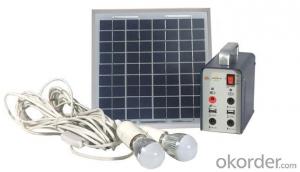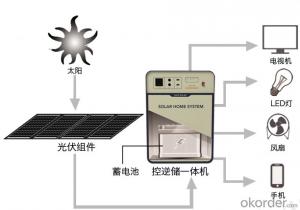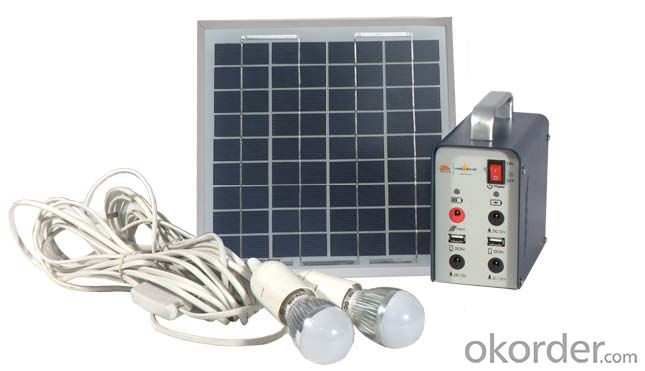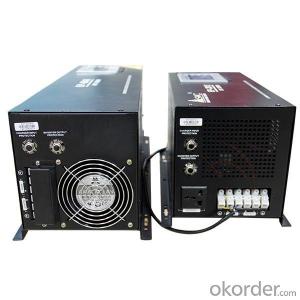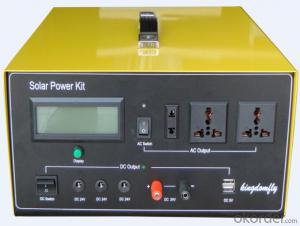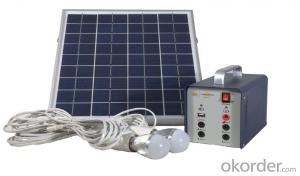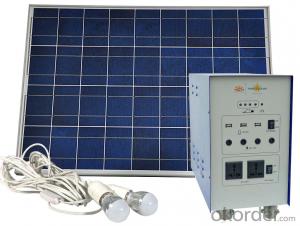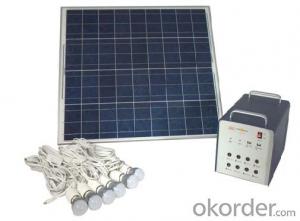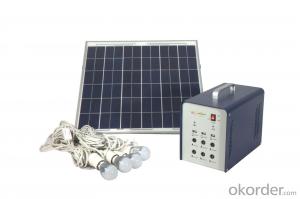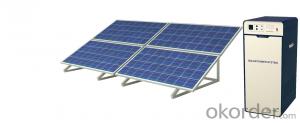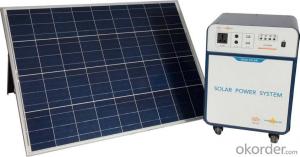Mirasol Solar Energy Systems Home Off-Grid Solar Power System DC Lighting JS-SPS-05
- Loading Port:
- Tianjin
- Payment Terms:
- TT OR LC
- Min Order Qty:
- 10 set
- Supply Capability:
- 10000 set/month
OKorder Service Pledge
Quality Product, Order Online Tracking, Timely Delivery
OKorder Financial Service
Credit Rating, Credit Services, Credit Purchasing
You Might Also Like
Off-grid Solar Power System
General Introduction
Solar power system provides alternating current and direct current, which is produced by the modules transforming solar power into power, to home lighting, household appliance and other DC appliance, such as cell phone and laptop.
Solar power system is widely used in area lack of power, for example house power supplying, monitoring, communication base, fire prevention in forest area, pasture and meadow, aquaculture etc.
We are dedicated to provide high quality off-grid PV products and systems to customers and has received a series of certificate, including ISO9001, TUV, UL, CE, CQC and RoHS.
General Introduction
Solar power system provides alternating current and direct current, which is produced by the modules transforming solar power into power, to home lighting, household appliance and other DC appliance, such as cell phone and laptop.
Solar power system is widely used in area lack of power, for example house power supplying, monitoring, communication base, fire prevention in forest area, pasture and meadow, aquaculture etc.
We are dedicated to provide high quality off-grid PV products and systems to customers and has received a series of certificate, including ISO9001, TUV, UL, CE, CQC and RoHS.
Solar DC Lighting System
Multiple protection system, safe and reliable performance.
Integrated and portable design, easy operation.
DC5V, DC12V, AC220V output, wide range application.
Clean engergy, cycle use.
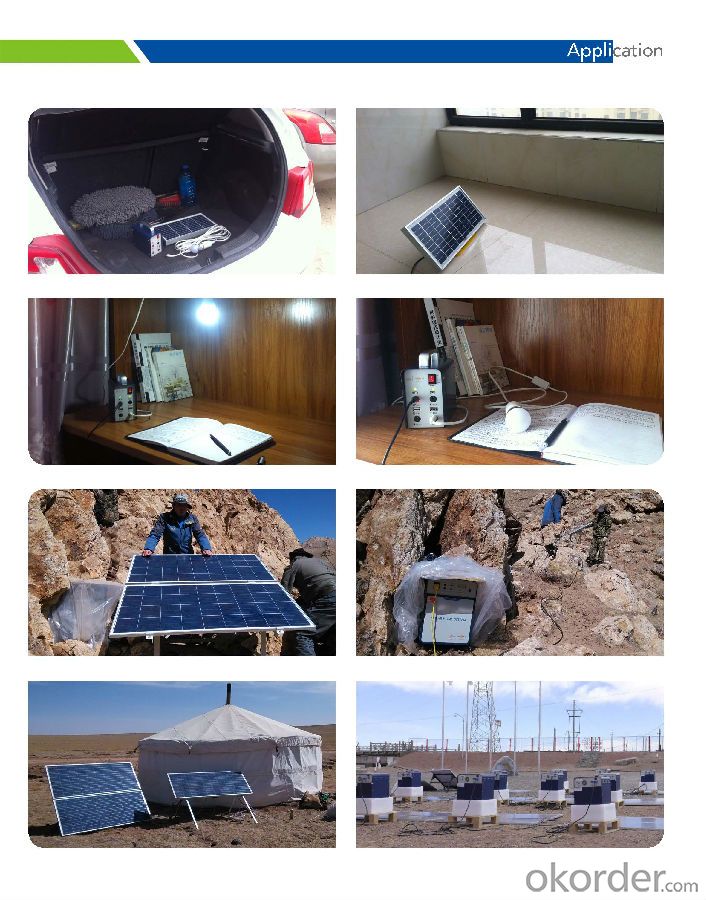
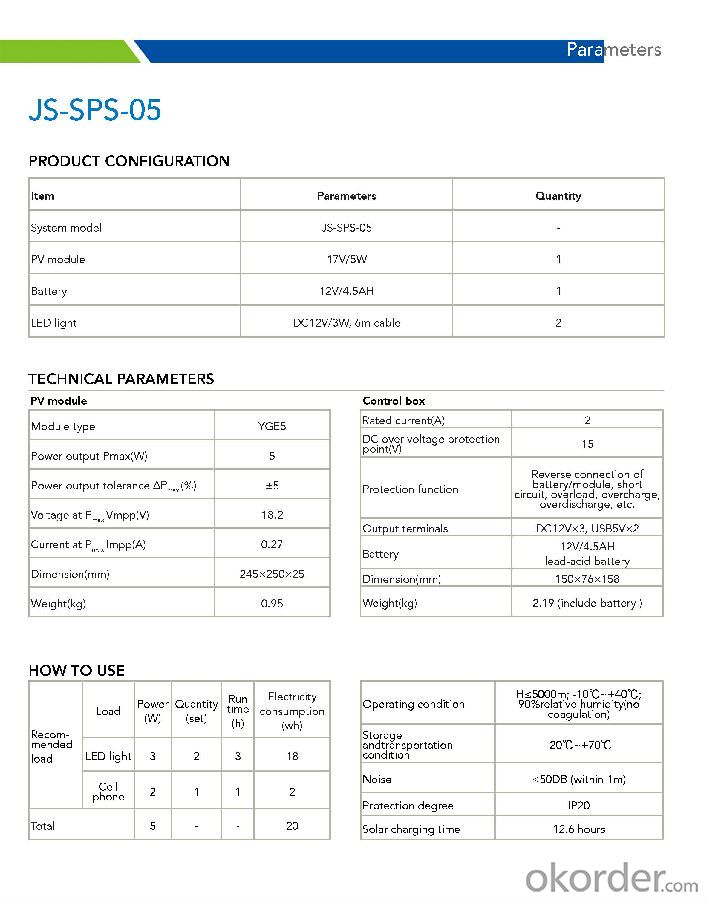

- Q: Can solar energy systems be used for powering remote cabins or cottages?
- Yes, solar energy systems can be effectively used for powering remote cabins or cottages. Since these locations are typically situated far away from utility power grids, solar panels can harness sunlight and convert it into usable electricity to meet the energy needs of these off-grid properties. With advancements in solar technology, it is now possible to design systems that can generate enough power to run appliances, lighting, heating, and other electrical devices in remote cabins or cottages. Additionally, energy storage solutions like batteries can be integrated into the system to ensure a constant power supply even during periods of low sunlight.
- Q: Can solar energy systems be used in areas with high levels of windborne debris?
- Yes, solar energy systems can be used in areas with high levels of windborne debris. However, it is important to consider certain factors to ensure their effectiveness and longevity. Installing protective measures such as a sturdy frame, debris shields, or regular cleaning and maintenance can help mitigate any potential damage caused by windborne debris.
- Q: What is the future of solar energy technology?
- The future of solar energy technology looks promising. With advancements in efficiency and cost reduction, solar power is expected to play an increasingly significant role in our energy mix. Continued research and development will likely lead to innovative solutions such as solar panels integrated into building materials and more efficient energy storage systems. Additionally, the integration of solar power with emerging technologies like artificial intelligence and Internet of Things can further enhance its potential. As the world transitions towards cleaner and renewable energy sources, solar energy technology is expected to continue its growth trajectory and contribute significantly to a sustainable and greener future.
- Q: What is the impact of lightning on solar panels?
- The impact of lightning on solar panels can be significant and potentially damaging. Lightning strikes can cause immediate damage to the solar panels themselves, leading to malfunctions or complete destruction. The intense heat generated by lightning can melt or vaporize the materials used in the solar panels, resulting in irreparable damage. Moreover, lightning strikes can also cause electrical surges that can travel through the solar panel system and damage other connected equipment, such as inverters, charge controllers, or batteries. These power surges can overload and fry the delicate electrical components within the system, rendering them inoperable. To mitigate the impact of lightning, solar panel installations often include surge protectors or lightning arrestors to redirect the high-voltage electrical currents away from the solar panels and other sensitive equipment. These protective measures help to minimize the risk of damage to the solar panel system. However, even with these precautions in place, lightning strikes can still pose a threat to solar panels. Therefore, it is advisable to have a comprehensive insurance policy that covers lightning damage for solar panel installations. Regular maintenance and inspection of the solar panel system can also help identify any potential issues caused by lightning strikes and enable timely repairs. Overall, the impact of lightning on solar panels can be detrimental, leading to immediate damage and potential long-term consequences for the entire solar panel system. Taking precautionary measures, having proper insurance coverage, and monitoring the system's condition are essential to minimize the risk and ensure the longevity of solar panel installations.
- Q: Can a solar energy system be used to power electric vehicles?
- Indeed, electric vehicles can benefit from the utilization of solar energy systems. Sun-absorbing panels can be conveniently mounted on rooftops or other appropriate surfaces to harness sunlight and transform it into usable electricity. This generated power can subsequently be employed to charge the batteries of electric vehicles, thereby offering a clean and sustainable energy source. In fact, numerous individuals have already embraced solar energy to fuel their electric cars, paving the way for a greener and more environmentally friendly transportation alternative. Furthermore, continuous progressions in solar technology have enhanced its efficiency and affordability, rendering it an increasingly feasible choice for powering electric vehicles.
- Q: Can solar energy systems be used in areas with limited access to solar surge protection devices?
- Yes, solar energy systems can be used in areas with limited access to solar surge protection devices. While surge protection devices are important for protecting solar panels and other system components from power surges and voltage spikes, there are alternative methods to mitigate the risks. These can include using high-quality solar inverters with built-in surge protection, implementing proper grounding techniques, and adhering to best practices in system design and installation. Although having access to surge protection devices is ideal, it is not a definitive requirement for the deployment of solar energy systems in areas with limited access to such equipment.
- Q: Can solar energy systems be used for powering security cameras?
- Certainly, security cameras can indeed be powered by solar energy systems. The conversion of sunlight into electricity by solar panels enables the storage of energy in batteries or direct powering of different devices, such as security cameras. Consequently, solar energy emerges as an excellent and sustainable option for remote or off-grid areas where the installation of electrical cables might pose challenges or incur high expenses. Moreover, solar-powered security cameras possess the advantageous ability to function without interruption, provided there is an ample supply of sunlight to generate electricity. Consequently, they prove to be a dependable and environmentally friendly alternative for surveillance systems.
- Q: Can solar energy systems be used in areas with limited access to storage solutions?
- Yes, solar energy systems can be used in areas with limited access to storage solutions. In such cases, solar energy can be utilized directly as it is generated during daylight hours, without the need for storage. This is particularly beneficial in regions with abundant sunlight, where solar power can provide a reliable and sustainable source of electricity during daylight hours, reducing the reliance on traditional energy sources and minimizing the need for storage solutions.
- Q: How do solar energy systems affect the electrical wiring of a building?
- Solar energy systems can affect the electrical wiring of a building by integrating directly into the existing electrical system. This usually involves the installation of additional equipment such as inverters and meters, as well as the connection of solar panels to the main electrical panel. This integration allows for the generation of solar power to supplement or replace the electricity provided by the utility grid, ultimately reducing reliance on traditional power sources. Overall, solar energy systems require careful planning and installation to ensure compatibility and safety with the building's electrical wiring.
- Q: What is the impact of hail on solar panels?
- Hail can potentially cause damage to solar panels due to its impact force. The size, density, and velocity of hailstones determine the severity of the impact. Hail can crack or shatter solar panels, leading to reduced efficiency or complete failure of the system. However, advancements in solar panel design and materials have made them more resilient to hail damage, with many panels tested to withstand hailstones of a certain size and speed.
Send your message to us
Mirasol Solar Energy Systems Home Off-Grid Solar Power System DC Lighting JS-SPS-05
- Loading Port:
- Tianjin
- Payment Terms:
- TT OR LC
- Min Order Qty:
- 10 set
- Supply Capability:
- 10000 set/month
OKorder Service Pledge
Quality Product, Order Online Tracking, Timely Delivery
OKorder Financial Service
Credit Rating, Credit Services, Credit Purchasing
Similar products
Hot products
Hot Searches
Related keywords
